RENAULT CLIO 2009 X85 / 3.G Owners Manual
Manufacturer: RENAULT, Model Year: 2009, Model line: CLIO, Model: RENAULT CLIO 2009 X85 / 3.GPages: 264, PDF Size: 15.68 MB
Page 191 of 264

Downloaded from www.Manualslib.com manuals search engine
JauneNoirNoir texte
5.3
ENG_UD10596_1Roue de secours (X85 - B85 - C85 - S85 - K85 - Renault)ENG_NU_853-3_BCSK85_Renault_5
Make sure that no-one has their fingers close to the cable when you move the handle: risk of injury.
EMERGENCY SPARE WHEEL (2/4)
To refit a wheel
To carry out this operation, the cable must be unwound.
If the cable has been wound back up on its own, unwind it again as follows:
– pull the handle to unwind the cable;
– press the button located under
handle 6 to hold the unwound cable, then guide it down;
– recover the cable from underneath
the vehicle.
You may refit the wheel.
Position yourself behind the vehicle and
pull handle 6 to raise the wheel until it is anchored under the vehicle.
After changing a wheel, position the replaced wheel on support 9, with the valve facing the ground. Clip cable 7 in its housing 8 then push the wheel under the luggage compartment.
Ensure that tab 10 is positioned to- wards the rear of the vehicle.
678
9
10
Page 192 of 264
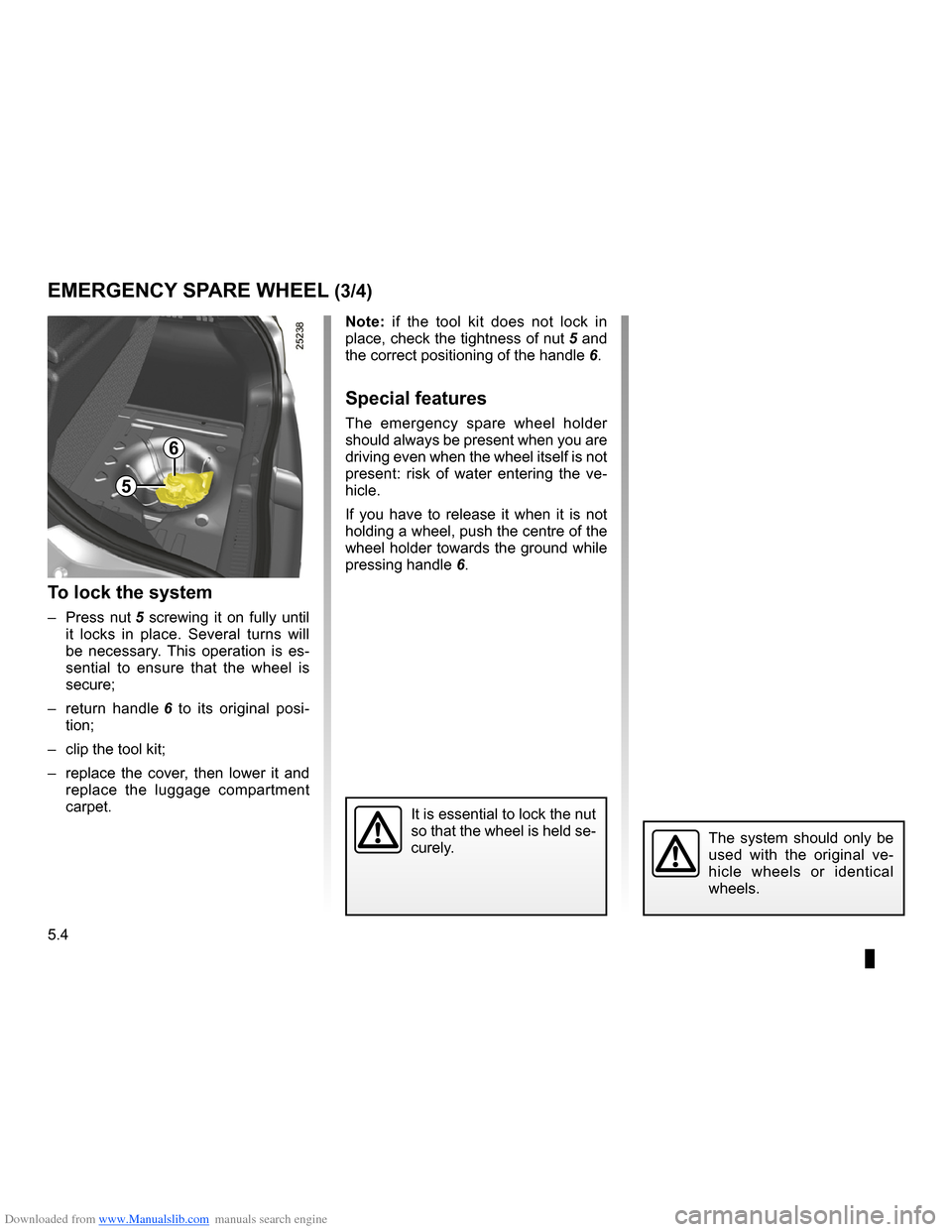
Downloaded from www.Manualslib.com manuals search engine
5.4
ENG_UD10596_1Roue de secours (X85 - B85 - C85 - S85 - K85 - Renault)ENG_NU_853-3_BCSK85_Renault_5
JauneNoirNoir texte
Note: if the tool kit does not lock in
place, check the tightness of nut 5 and
the correct positioning of the handle 6.
Special features
The emergency spare wheel holder should always be present when you are driving even when the wheel itself is not present: risk of water entering the ve- hicle.
If you have to release it when it is not holding a wheel, push the centre of the wheel holder towards the ground while pressing handle 6.
To lock the system
– Press nut 5 screwing it on fully until it locks in place. Several turns will be necessary. This operation is es- sential to ensure that the wheel is secure;
– return handle
6 to its original posi- tion;
– clip the tool kit;
– replace the cover, then lower it and
replace the luggage compartment carpet.
EMERGENCY SPARE WHEEL (3/4)
The system should only be used with the original ve- hicle wheels or identical wheels.
It is essential to lock the nut so that the wheel is held se- curely.
6
5
Page 193 of 264
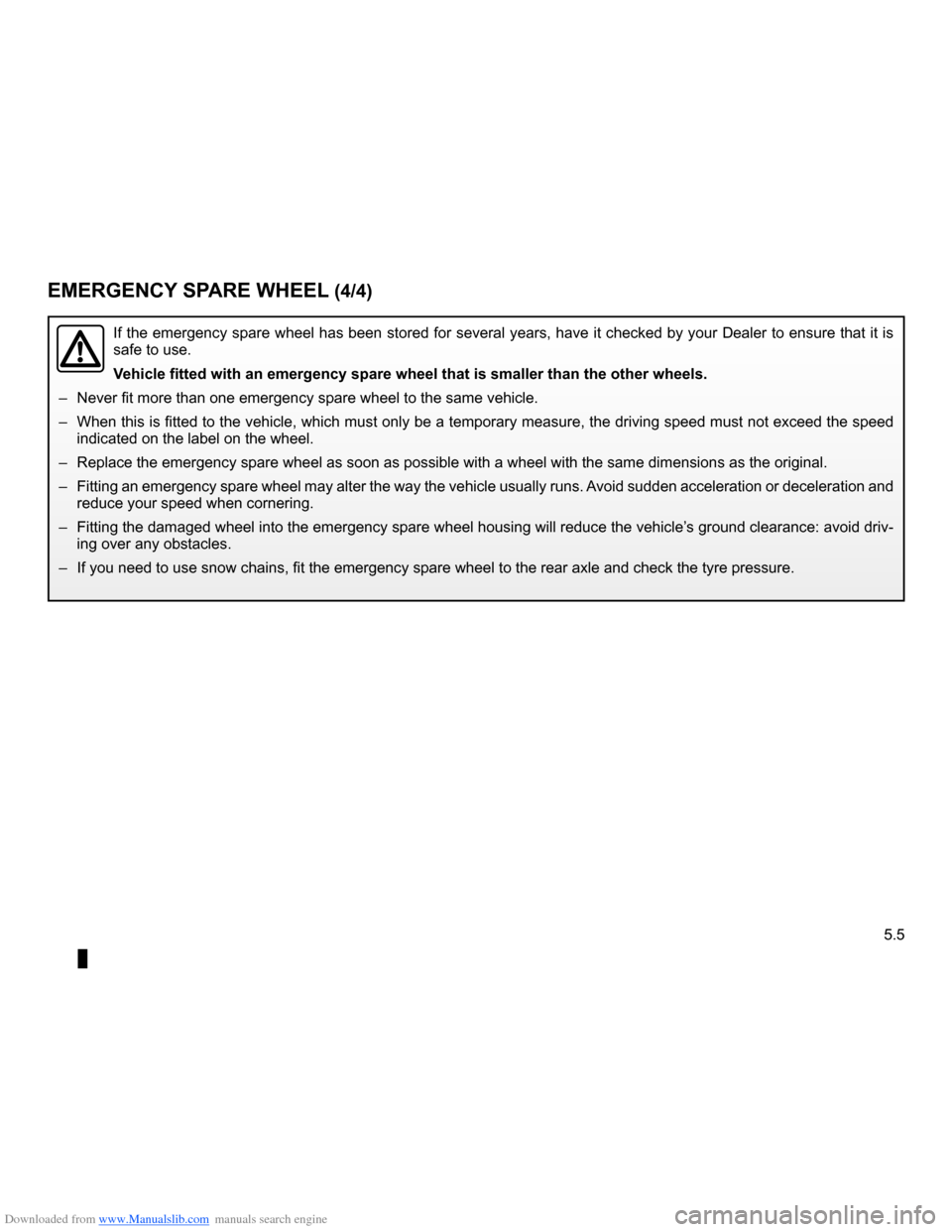
Downloaded from www.Manualslib.com manuals search engine
JauneNoirNoir texte
5.5
ENG_UD10596_1Roue de secours (X85 - B85 - C85 - S85 - K85 - Renault)ENG_NU_853-3_BCSK85_Renault_5
If the emergency spare wheel has been stored for several years, have it checked by your Dealer to ensure that it is safe to use.
Vehicle fitted with an emergency spare wheel that is smaller than the oth\
er wheels.
– Never fit more than one emergency spare wheel to the same vehicle.
– When this is fitted to the vehicle, which must only be a temporary measure, the driving speed must not exceed the speed
indicated on the label on the wheel.
– Replace the emergency spare wheel as soon as possible with a wheel with the same dimensions as the original.
– Fitting an emergency spare wheel may alter the way the vehicle usually runs. Avoid sudden acceleration or deceleration and
reduce your speed when cornering.
– Fitting the damaged wheel into the emergency spare wheel housing will reduce the vehicle’s ground clearance: avoid driv
- ing over any obstacles.
– If you need to use snow chains, fit the emergency spare wheel to the rear axle and check the tyre pressure.
EMERGENCY SPARE WHEEL (4/4)
Page 194 of 264
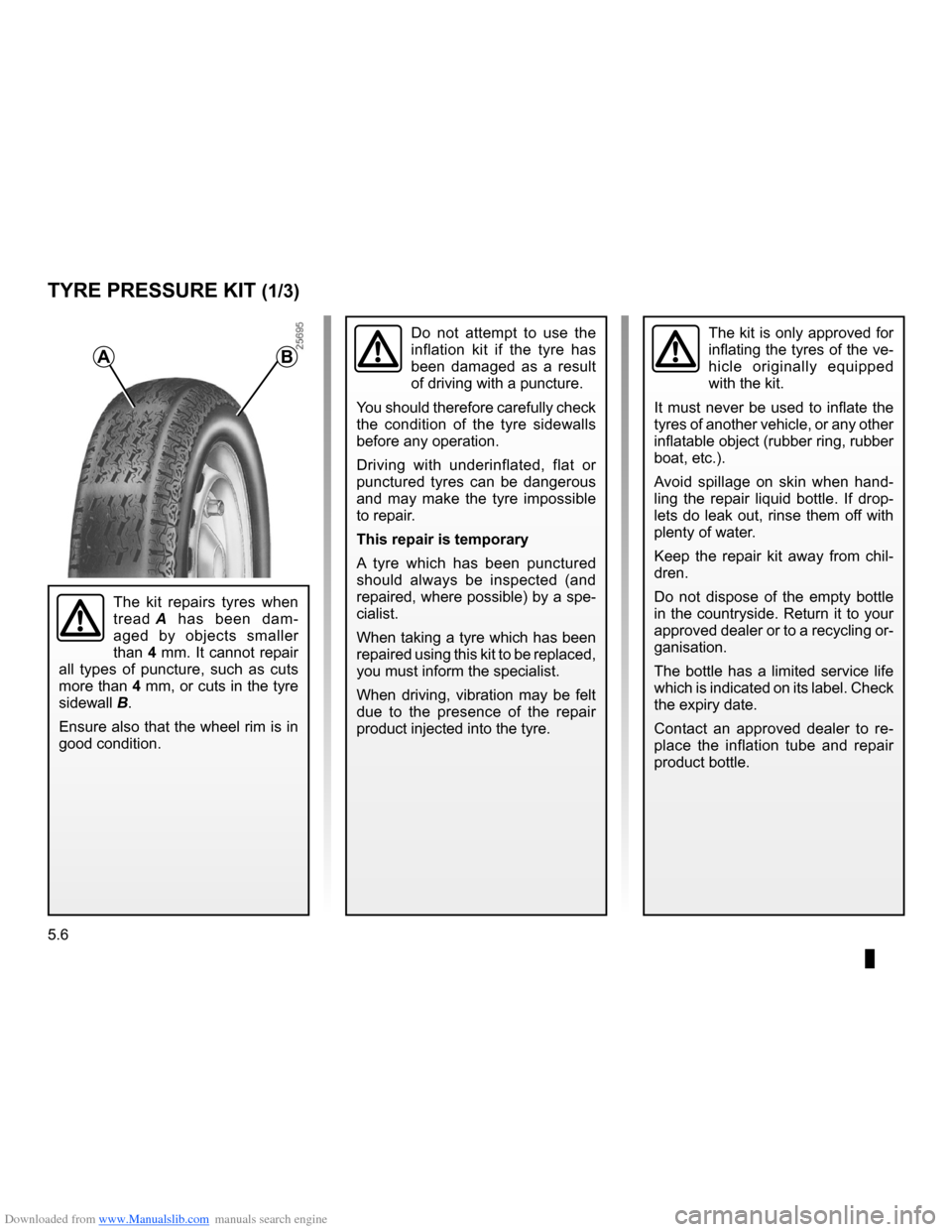
Downloaded from www.Manualslib.com manuals search engine
tyre inflation kit......................................(up to the end of the DU)
5.6
ENG_UD12589_2Kit de gonflage des pneumatiques (X85 - B85 - C85 - S85 - K85 - Renault\
)ENG_NU_853-3_BCSK85_Renault_5
JauneNoirNoir texte
Tyre inflation kit
TYRE PRESSURE KIT (1/3)
AB
Do not attempt to use the inflation kit if the tyre has been damaged as a result of driving with a puncture.
You should therefore carefully check the condition of the tyre sidewalls before any operation.
Driving with underinflated, flat or punctured tyres can be dangerous and may make the tyre impossible to repair.
This repair is temporary
A tyre which has been punctured should always be inspected (and repaired, where possible) by a spe- cialist.
When taking a tyre which has been repaired using this kit to be replaced, you must inform the specialist.
When driving, vibration may be felt due to the presence of the repair product injected into the tyre.
The kit is only approved for inflating the tyres of the ve- hicle originally equipped with the kit.
It must never be used to inflate the tyres of another vehicle, or any other inflatable object (rubber ring, rubber boat, etc.).
Avoid spillage on skin when hand- ling the repair liquid bottle. If drop- lets do leak out, rinse them off with plenty of water.
Keep the repair kit away from chil- dren.
Do not dispose of the empty bottle in the countryside. Return it to your approved dealer or to a recycling or- ganisation.
The bottle has a limited service life which is indicated on its label. Check the expiry date.
Contact an approved dealer to re- place the inflation tube and repair product bottle.
The kit repairs tyres when
tread A has been dam- aged by objects smaller than 4 mm. It cannot repair all types of puncture, such as cuts more than 4 mm, or cuts in the tyre
sidewall B.
Ensure also that the wheel rim is in good condition.
Page 195 of 264
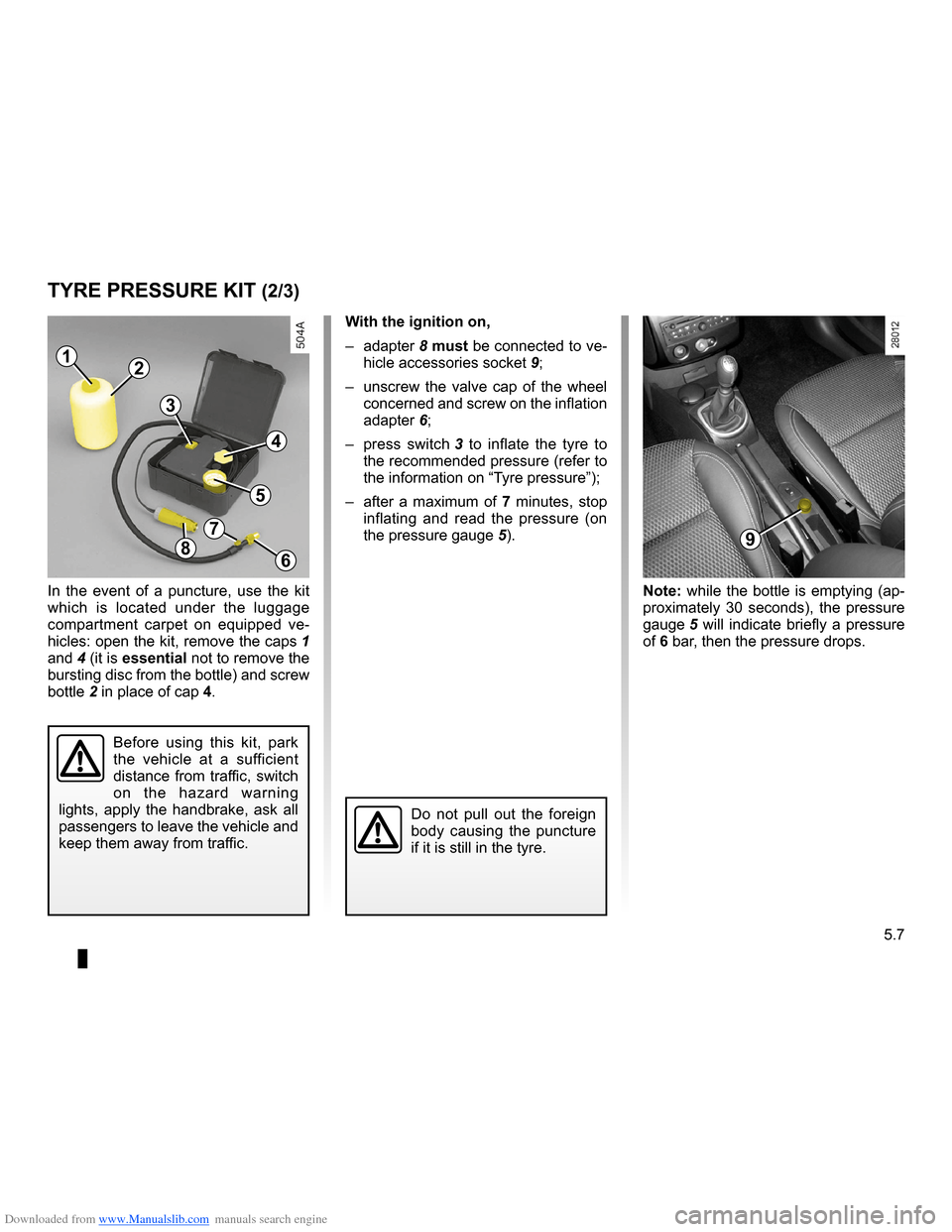
Downloaded from www.Manualslib.com manuals search engine
JauneNoirNoir texte
5.7
ENG_UD12589_2Kit de gonflage des pneumatiques (X85 - B85 - C85 - S85 - K85 - Renault\
)ENG_NU_853-3_BCSK85_Renault_5
TYRE PRESSURE KIT (2/3)
In the event of a puncture, use the kit which is located under the luggage compartment carpet on equipped ve-
hicles: open the kit, remove the caps 1
and 4 (it is essential not to remove the bursting disc from the bottle) and screw
bottle 2 in place of cap 4.
Do not pull out the foreign body causing the puncture if it is still in the tyre.
With the ignition on,
– adapter
8 must be connected to ve-
hicle accessories socket 9;
– unscrew the valve cap of the wheel
concerned and screw on the inflation
adapter 6;
– press switch
3 to inflate the tyre to the recommended pressure (refer to the information on “Tyre pressure”);
– after a maximum of
7 minutes, stop inflating and read the pressure (on
the pressure gauge 5).
Note: while the bottle is emptying (ap- proximately 30 seconds), the pressure
gauge 5 will indicate briefly a pressure of 6 bar, then the pressure drops.
1
3
4
5
6
7
89
Before using this kit, park
the vehicle at a sufficient distance from traffic, switch on the hazard warning lights, apply the handbrake, ask all passengers to leave the vehicle and keep them away from traffic.
2
Page 196 of 264
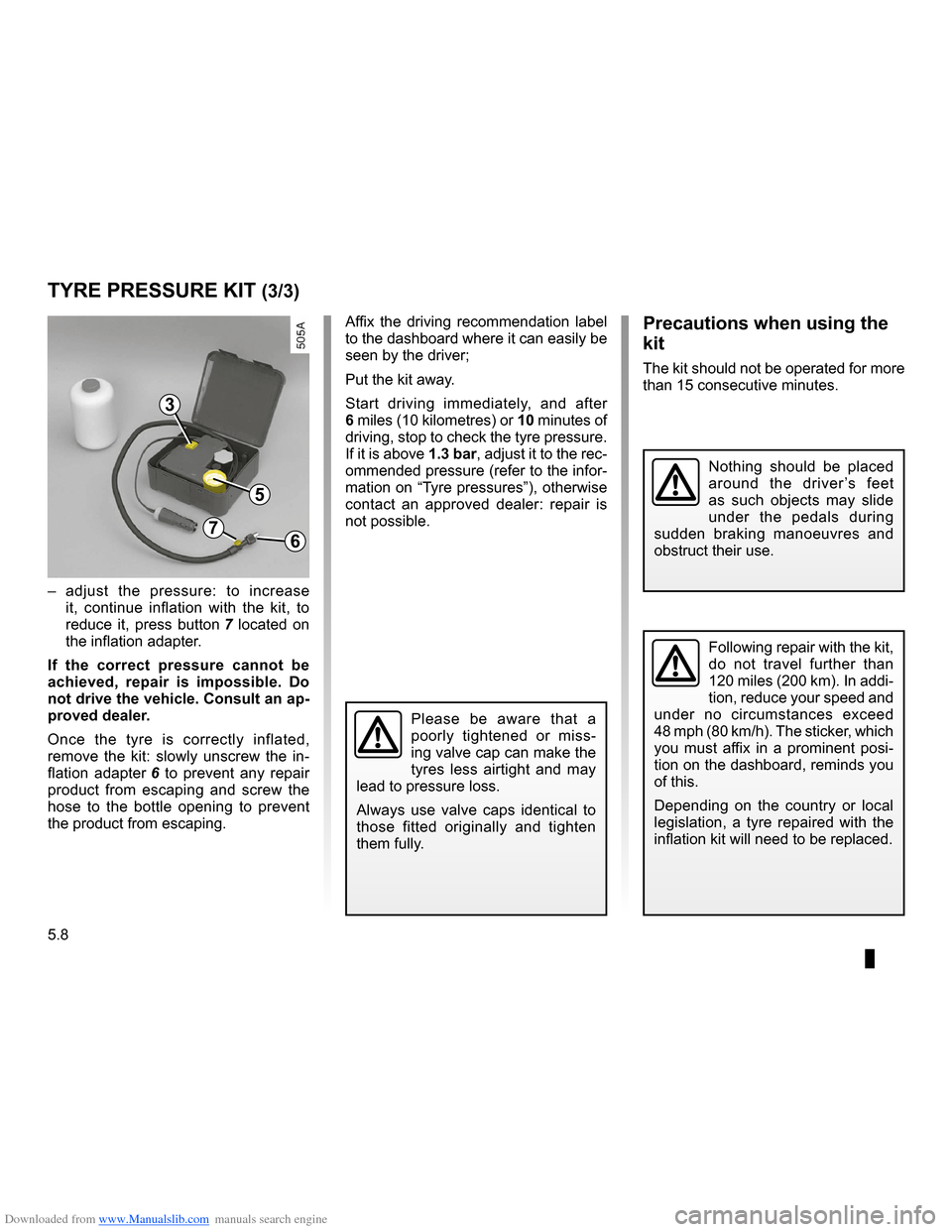
Downloaded from www.Manualslib.com manuals search engine
5.8
ENG_UD12589_2Kit de gonflage des pneumatiques (X85 - B85 - C85 - S85 - K85 - Renault\
)ENG_NU_853-3_BCSK85_Renault_5
TYRE PRESSURE KIT (3/3)
– adjust the pressure: to increase it, continue inflation with the kit, to
reduce it, press button 7 located on the inflation adapter.
If the correct pressure cannot be achieved, repair is impossible. Do not drive the vehicle. Consult an ap- proved dealer.
Once the tyre is correctly inflated, remove the kit: slowly unscrew the in-
flation adapter 6 to prevent any repair product from escaping and screw the hose to the bottle opening to prevent the product from escaping.
Affix the driving recommendation label to the dashboard where it can easily be seen by the driver;
Put the kit away.
Start driving immediately, and after 6 miles (10 kilometres) or 10 minutes of driving, stop to check the tyre pressure. If it is above 1.3 bar, adjust it to the rec- ommended pressure (refer to the infor- mation on “Tyre pressures”), otherwise contact an approved dealer: repair is not possible.
Precautions when using the
kit
The kit should not be operated for more than 15 consecutive minutes.
Following repair with the kit, do not travel further than 120 miles (200 km). In addi- tion, reduce your speed and under no circumstances exceed 48 mph (80 km/h). The sticker, which you must affix in a prominent posi- tion on the dashboard, reminds you of this.
Depending on the country or local legislation, a tyre repaired with the
inflation kit will need to be replaced.
3
5
7
Nothing should be placed around the driver ’s feet as such objects may slide under the pedals during
sudden braking manoeuvres and obstruct their use.6
Please be aware that a poorly tightened or miss- ing valve cap can make the tyres less airtight and may lead to pressure loss.
Always use valve caps identical to those fitted originally and tighten them fully.
Page 197 of 264
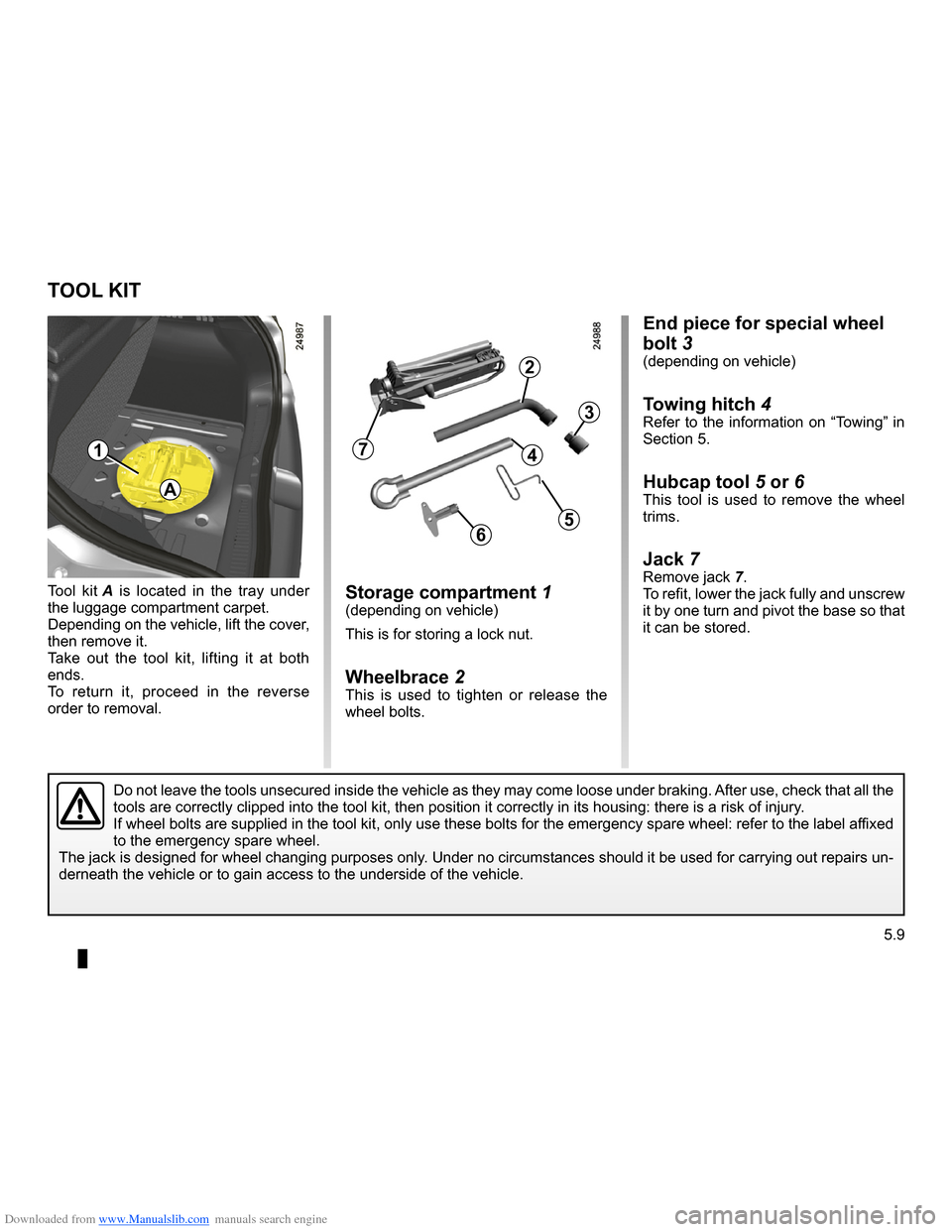
Downloaded from www.Manualslib.com manuals search engine
tool kit ...................................................(up to the end of the DU)hubcap tool ...........................................(up to the end of the DU)jack .......................................................(up to the end of the DU)wheelbrace ...........................................(up to the end of the DU)towing hitch...........................................(up to the end of the DU)wheelbrace ...........................................(up to the end of the DU)puncture................................................(up to the end of the DU)
5.9
ENG_UD12590_2Bloc-outils (X85 - B85 - C85 - S85 - K85 - Renault)ENG_NU_853-3_BCSK85_Renault_5
End piece for special wheel
bolt
3(depending on vehicle)
Towing hitch 4Refer to the information on “Towing” in Section 5.
Hubcap tool 5 or 6This tool is used to remove the wheel trims.
Jack 7Remove jack 7.To refit, lower the jack fully and unscrew it by one turn and pivot the base so that it can be stored.
Storage compartment 1(depending on vehicle)
This is for storing a lock nut.
Wheelbrace 2This is used to tighten or release the wheel bolts.
Tool kit
A is located in the tray under the luggage compartment carpet.Depending on the vehicle, lift the cover, then remove it.Take out the tool kit, lifting it at both ends.To return it, proceed in the reverse order to removal.
TOOL KIT
Tool kit (jack, wheelbrace, etc.)
1
A
7
2
3
4
56
Do not leave the tools unsecured inside the vehicle as they may come loose under braking. After use, check that all the tools are correctly clipped into the tool kit, then position it correctl\
y in its housing: there is a risk of injury.If wheel bolts are supplied in the tool kit, only use these bolts for the emergency spare wheel: refer to the label affixed to the emergency spare wheel.
The jack is designed for wheel changing purposes only. Under no circumstances should it be used for carrying out repairs un- derneath the vehicle or to gain access to the underside of the vehicle.
Page 198 of 264

Downloaded from www.Manualslib.com manuals search engine
hubcap tool ...........................................(up to the end of the DU)trims ......................................................(up to the end of the DU)
5.10
ENG_UD10599_1Enjoliveur - Roue (X85 - B85 - C85 - S85 - K85 - Renault)ENG_NU_853-3_BCSK85_Renault_5
Wheel trims - wheel
We would advise you to note down the number engraved on the tool so that you can replace it if it is lost.
Central wheel hubcap
(example: hubcap 4)
To remove it, insert the hubcap tool 6 (located in the tool kit) into recess 5.
To refit it, position it in line with recess 5 and tighten it with tool 6.
Hubcap (example hubcap 1)
Remove the wheel trim using hubcap
tool 2 (located in the tool kit) by en- gaging the hook in the opening near
valve 3.
To refit it, align it with valve 3. Push the retaining hooks in fully, starting with side A near the valve, followed by B and C, finishing at D opposite the
valve.
WHEEL TRIMS - WHEEL
1
4
5
6
2
3
D
C
A
B
Do not leave the tools un- secured inside the vehicle as they may come loose under braking. After use, check that all the tools are correctly clipped into the tool kit, then position it correctly in its housing: there is a risk of injury.If wheel bolts are supplied in the tool kit, only use these bolts for the emergency spare wheel: refer to the label affixed to the emergency spare wheel.The jack is designed for wheel changing purposes only. Under no circumstances should it be used for carrying out repairs underneath the vehicle or to gain access to the un- derside of the vehicle.
Page 199 of 264
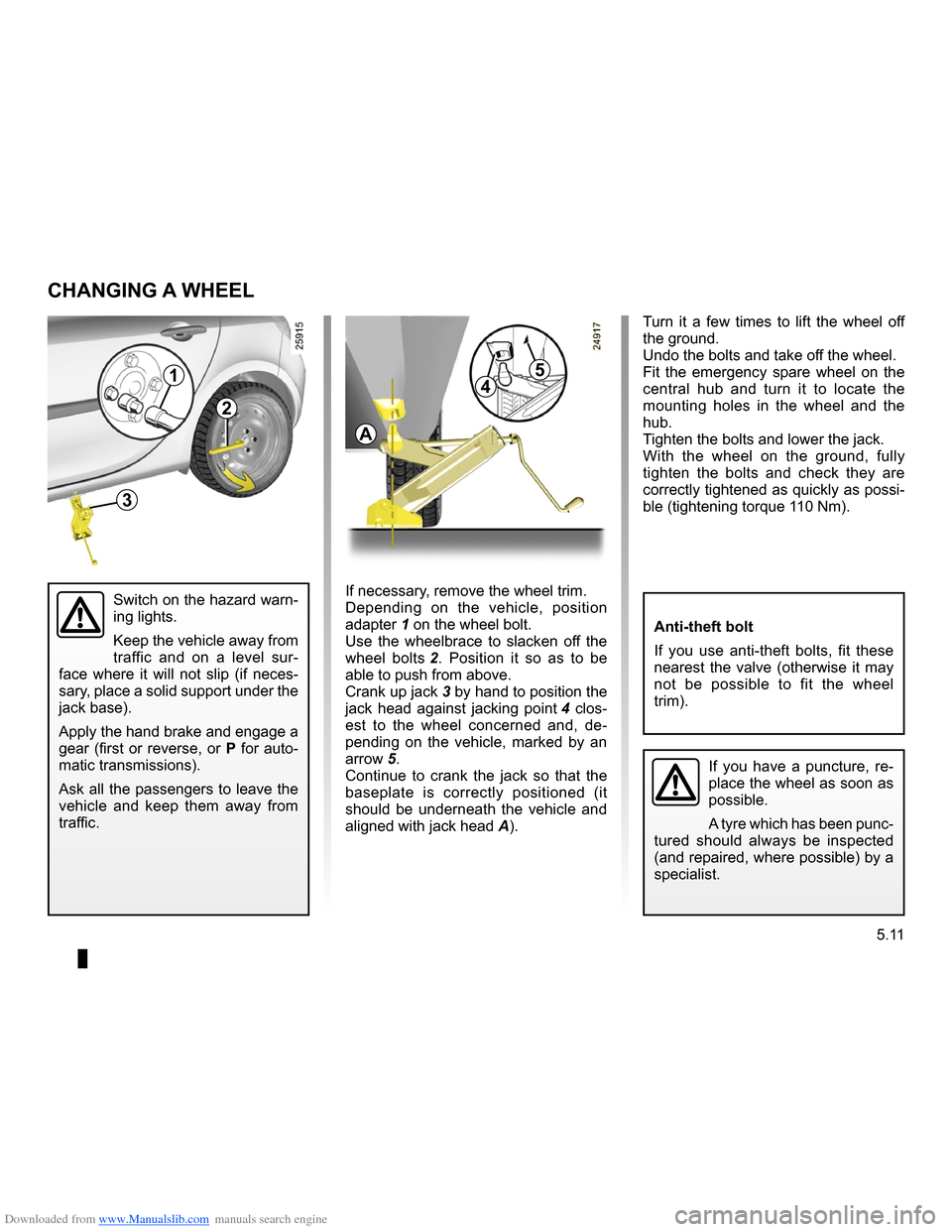
Downloaded from www.Manualslib.com manuals search engine
changing a wheel..................................(up to the end of the DU)lifting the vehiclechanging a wheel ............................(up to the end of the DU)
5.11
ENG_UD10600_1Changement de roue (X85 - B85 - C85 - S85 - K85 - Renault)ENG_NU_853-3_BCSK85_Renault_5
Turn it a few times to lift the wheel off the ground.Undo the bolts and take off the wheel.Fit the emergency spare wheel on the central hub and turn it to locate the mounting holes in the wheel and the hub.Tighten the bolts and lower the jack.With the wheel on the ground, fully tighten the bolts and check they are correctly tightened as quickly as possi- ble (tightening torque 110 Nm).
Changing a wheel
If you have a puncture, re- place the wheel as soon as possible.
A tyre which has been punc- tured should always be inspected (and repaired, where possible) by a specialist.
Switch on the hazard warn- ing lights.
Keep the vehicle away from traffic and on a level sur- face where it will not slip (if neces- sary, place a solid support under the jack base).
Apply the hand brake and engage a gear (first or reverse, or P for auto- matic transmissions).
Ask all the passengers to leave the vehicle and keep them away from traffic.
CHANGING A WHEEL
A
5
4
3
2
1
Anti-theft bolt
If you use anti-theft bolts, fit these nearest the valve (otherwise it may not be possible to fit the wheel trim).
If necessary, remove the wheel trim.Depending on the vehicle, position adapter 1 on the wheel bolt.Use the wheelbrace to slacken off the
wheel bolts 2. Position it so as to be able to push from above.
Crank up jack 3 by hand to position the
jack head against jacking point 4 clos- est to the wheel concerned and, de- pending on the vehicle, marked by an
arrow 5.Continue to crank the jack so that the baseplate is correctly positioned (it should be underneath the vehicle and
aligned with jack head A).
Page 200 of 264

Downloaded from www.Manualslib.com manuals search engine
tyres ......................................................(up to the end of the DU)wheels (safety) .....................................(up to the end of the DU)
5.12
ENG_UD10601_1Pneumatiques (X85 - B85 - C85 - S85 - K85 - Renault)ENG_NU_853-3_BCSK85_Renault_5
JauneNoirNoir texte
Tyre and wheel safety
The tyres are the only contact between the vehicle and the road, so it is essen- tial to keep them in good condition.
You must make sure that your tyres con- form to local road traffic regulations.
When the tyre tread has been worn to the level of the warning strips, they become visible 2: it is then neces- sary to replace your tyres because the tread rubber is now only 1.6 mm deep at most, resulting in poor road hold- ing on wet roads.
An overloaded vehicle, long journeys by motorway, particularly in very hot weather, or continual driving on poorly surfaced minor roads will lead to more rapid tyre wear and affect safety.
Tyres (tyre and wheel safety, use in winter)
Maintaining the tyres
The tyres must be in good condition and the tread form must have sufficient depth; tyres approved by our Technical D e p a r t m e n t h a v e w e a r w a r n i n g strips 1 which are indicators moulded into the tread at several points.
TYRES (1/3)
1
2
When they need to be re- placed, only tyres of the same make, size, type and profile should be used.
Tyres fitted to the vehicle should either be identical to those fitted originally or conform to those recommended by your approved dealer.
Incidents which occur when
driving, such as striking the kerb, may damage the tyres and wheel rims, and could also lead to misalignment of the front or rear axle geometry. In this case, have the condition of these checked by an approved dealer.